Nursing Theories and Models: Evaluation of Practice Approaches
VerifiedAdded on 2020/01/23
|15
|4757
|212
Report
AI Summary
This report evaluates nursing practice through the application of the Neuman Systems Model and Orem's Self-Care Deficit Theory. The introduction emphasizes the importance of these models in 21st-century nursing to provide optimal patient health and care. Section 1 details the Neuman Systems Model, discussing its core concepts, including stressors, lines of defense, and prevention modalities, along with its strengths and weaknesses. Section 1 also covers the Self-Care Nursing Deficit Theory, examining its concepts like human, environment, health, and self-care, including the strengths and weaknesses of the theory. Section 2 focuses on the rational of Orem's Self-Care Deficit Theory, highlighting its impact on social, physical, and psychological well-being, and its role in helping nurses manage patient needs. The report emphasizes the importance of self-assessment and the use of the five elements of this model such as assessment, nursing, diagnosis, interventions, implementation and evaluation for effective patient care. The conclusion summarizes the key findings and implications of both theories in nursing practice.
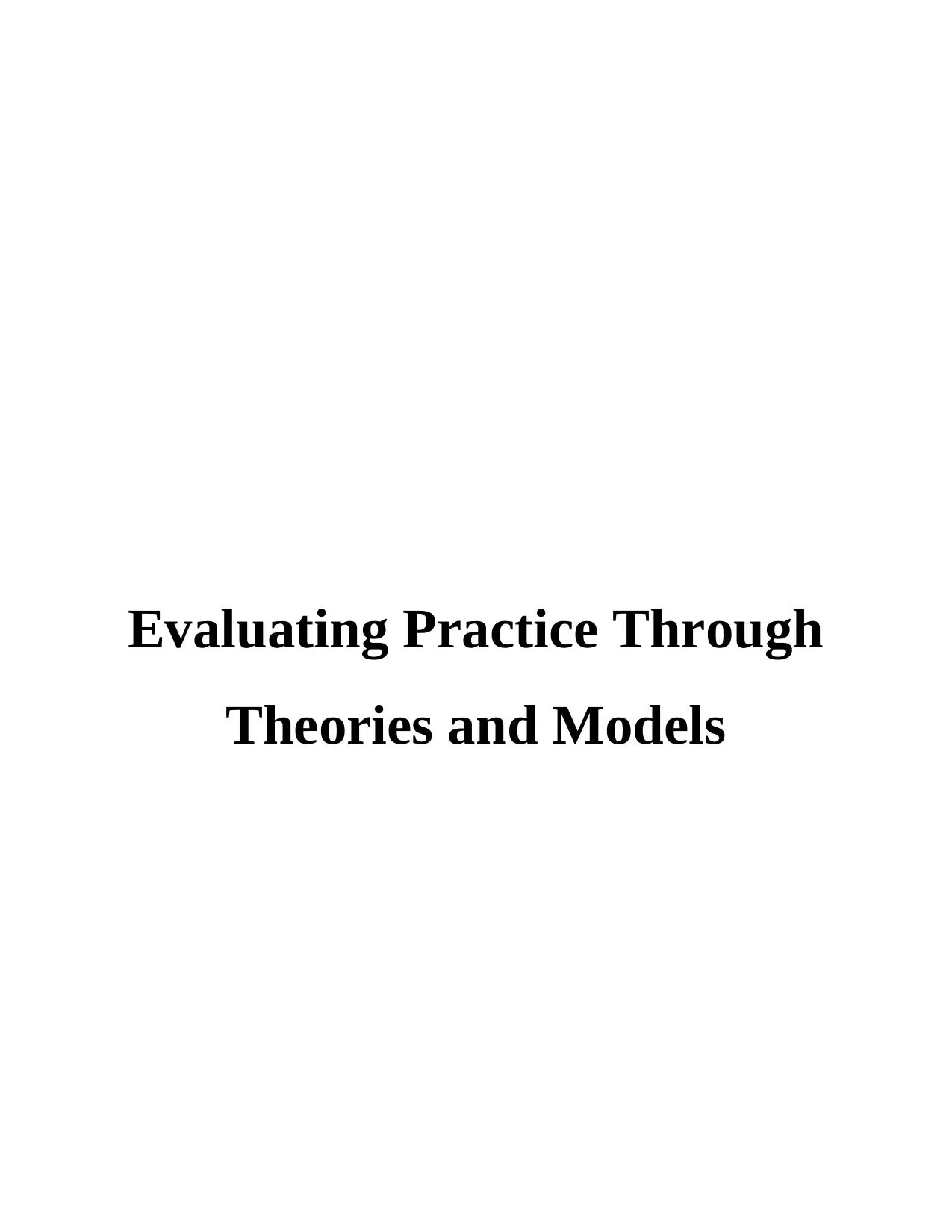
Evaluating Practice Through
Theories and Models
Theories and Models
Paraphrase This Document
Need a fresh take? Get an instant paraphrase of this document with our AI Paraphraser
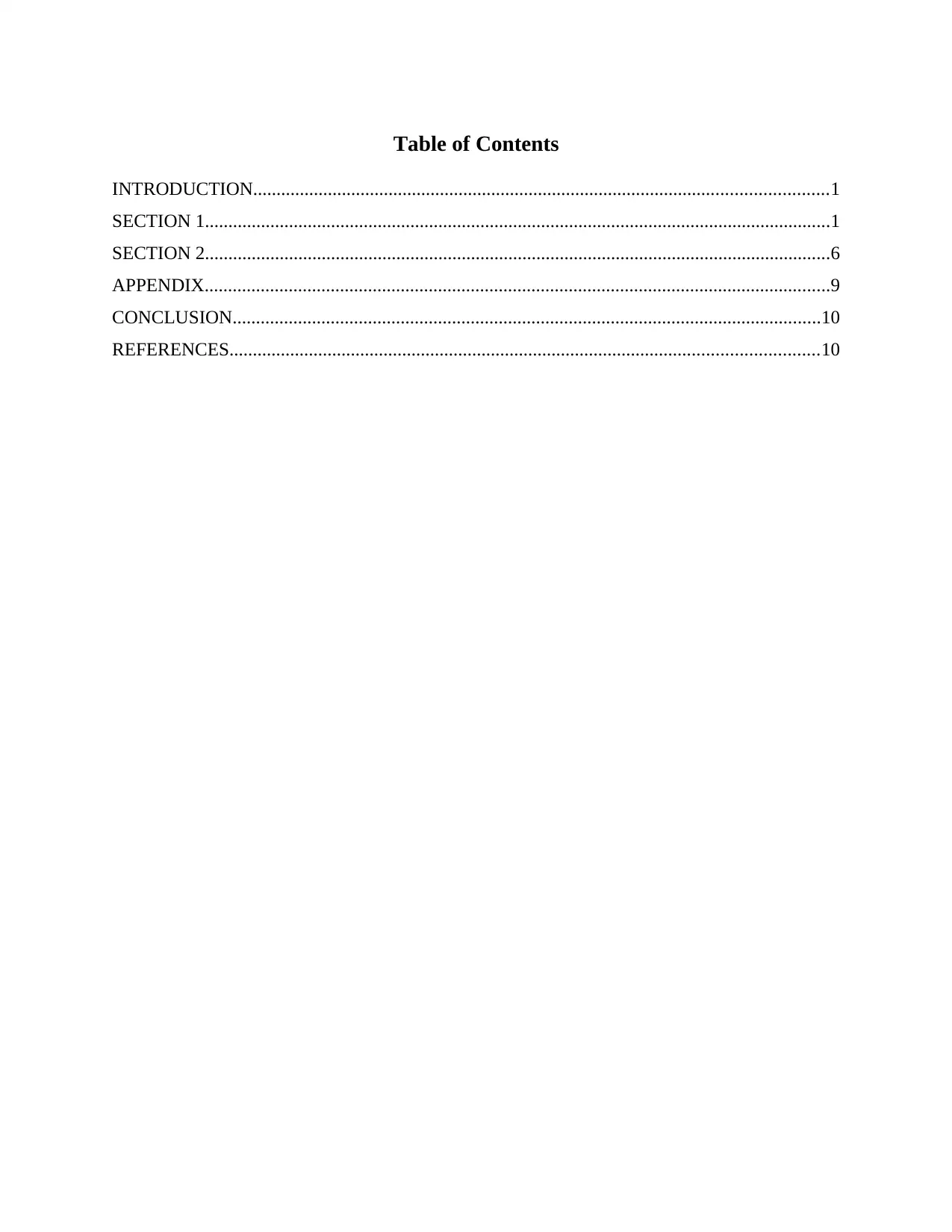
Table of Contents
INTRODUCTION...........................................................................................................................1
SECTION 1......................................................................................................................................1
SECTION 2......................................................................................................................................6
APPENDIX......................................................................................................................................9
CONCLUSION..............................................................................................................................10
REFERENCES..............................................................................................................................10
INTRODUCTION...........................................................................................................................1
SECTION 1......................................................................................................................................1
SECTION 2......................................................................................................................................6
APPENDIX......................................................................................................................................9
CONCLUSION..............................................................................................................................10
REFERENCES..............................................................................................................................10
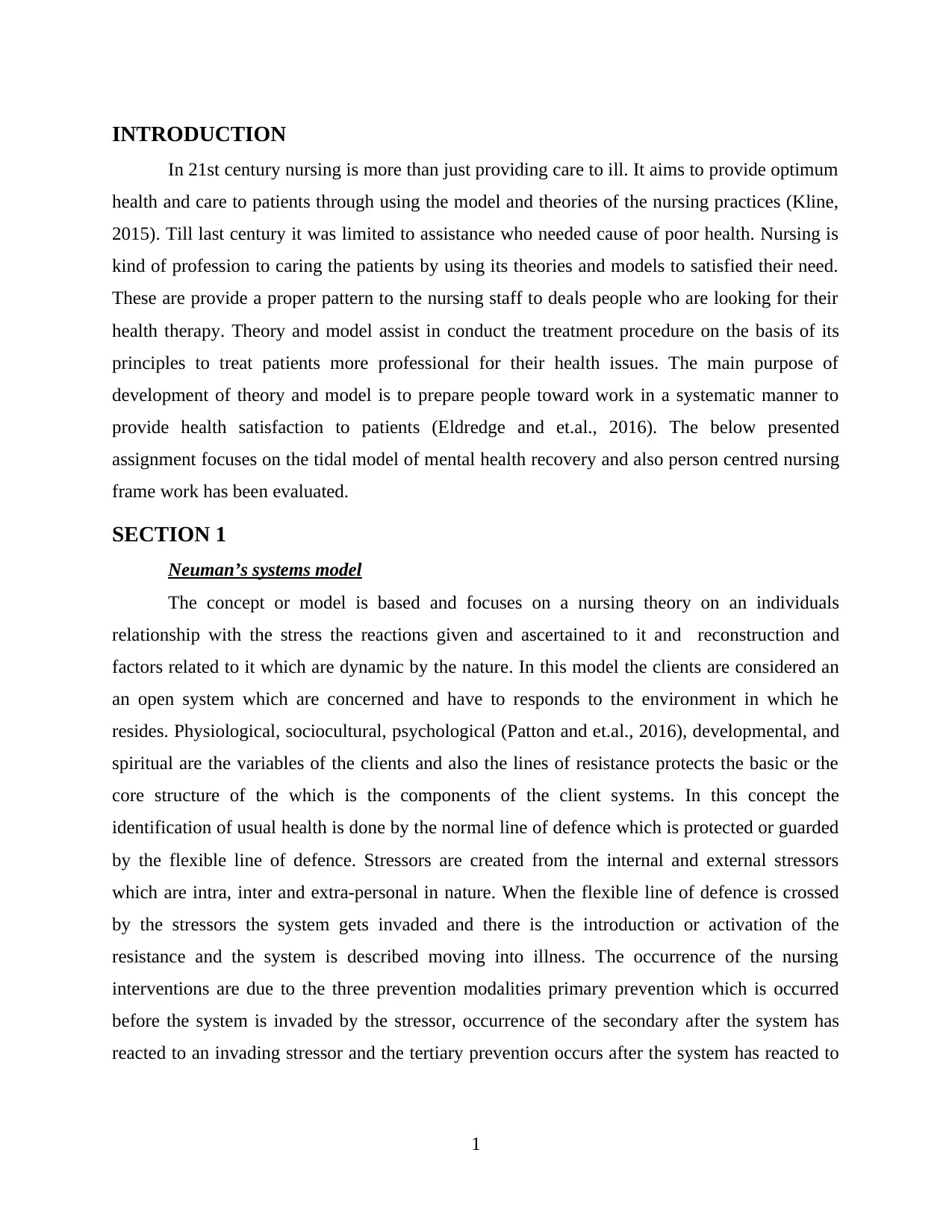
INTRODUCTION
In 21st century nursing is more than just providing care to ill. It aims to provide optimum
health and care to patients through using the model and theories of the nursing practices (Kline,
2015). Till last century it was limited to assistance who needed cause of poor health. Nursing is
kind of profession to caring the patients by using its theories and models to satisfied their need.
These are provide a proper pattern to the nursing staff to deals people who are looking for their
health therapy. Theory and model assist in conduct the treatment procedure on the basis of its
principles to treat patients more professional for their health issues. The main purpose of
development of theory and model is to prepare people toward work in a systematic manner to
provide health satisfaction to patients (Eldredge and et.al., 2016). The below presented
assignment focuses on the tidal model of mental health recovery and also person centred nursing
frame work has been evaluated.
SECTION 1
Neuman’s systems model
The concept or model is based and focuses on a nursing theory on an individuals
relationship with the stress the reactions given and ascertained to it and reconstruction and
factors related to it which are dynamic by the nature. In this model the clients are considered an
an open system which are concerned and have to responds to the environment in which he
resides. Physiological, sociocultural, psychological (Patton and et.al., 2016), developmental, and
spiritual are the variables of the clients and also the lines of resistance protects the basic or the
core structure of the which is the components of the client systems. In this concept the
identification of usual health is done by the normal line of defence which is protected or guarded
by the flexible line of defence. Stressors are created from the internal and external stressors
which are intra, inter and extra-personal in nature. When the flexible line of defence is crossed
by the stressors the system gets invaded and there is the introduction or activation of the
resistance and the system is described moving into illness. The occurrence of the nursing
interventions are due to the three prevention modalities primary prevention which is occurred
before the system is invaded by the stressor, occurrence of the secondary after the system has
reacted to an invading stressor and the tertiary prevention occurs after the system has reacted to
1
In 21st century nursing is more than just providing care to ill. It aims to provide optimum
health and care to patients through using the model and theories of the nursing practices (Kline,
2015). Till last century it was limited to assistance who needed cause of poor health. Nursing is
kind of profession to caring the patients by using its theories and models to satisfied their need.
These are provide a proper pattern to the nursing staff to deals people who are looking for their
health therapy. Theory and model assist in conduct the treatment procedure on the basis of its
principles to treat patients more professional for their health issues. The main purpose of
development of theory and model is to prepare people toward work in a systematic manner to
provide health satisfaction to patients (Eldredge and et.al., 2016). The below presented
assignment focuses on the tidal model of mental health recovery and also person centred nursing
frame work has been evaluated.
SECTION 1
Neuman’s systems model
The concept or model is based and focuses on a nursing theory on an individuals
relationship with the stress the reactions given and ascertained to it and reconstruction and
factors related to it which are dynamic by the nature. In this model the clients are considered an
an open system which are concerned and have to responds to the environment in which he
resides. Physiological, sociocultural, psychological (Patton and et.al., 2016), developmental, and
spiritual are the variables of the clients and also the lines of resistance protects the basic or the
core structure of the which is the components of the client systems. In this concept the
identification of usual health is done by the normal line of defence which is protected or guarded
by the flexible line of defence. Stressors are created from the internal and external stressors
which are intra, inter and extra-personal in nature. When the flexible line of defence is crossed
by the stressors the system gets invaded and there is the introduction or activation of the
resistance and the system is described moving into illness. The occurrence of the nursing
interventions are due to the three prevention modalities primary prevention which is occurred
before the system is invaded by the stressor, occurrence of the secondary after the system has
reacted to an invading stressor and the tertiary prevention occurs after the system has reacted to
1
⊘ This is a preview!⊘
Do you want full access?
Subscribe today to unlock all pages.

Trusted by 1+ million students worldwide
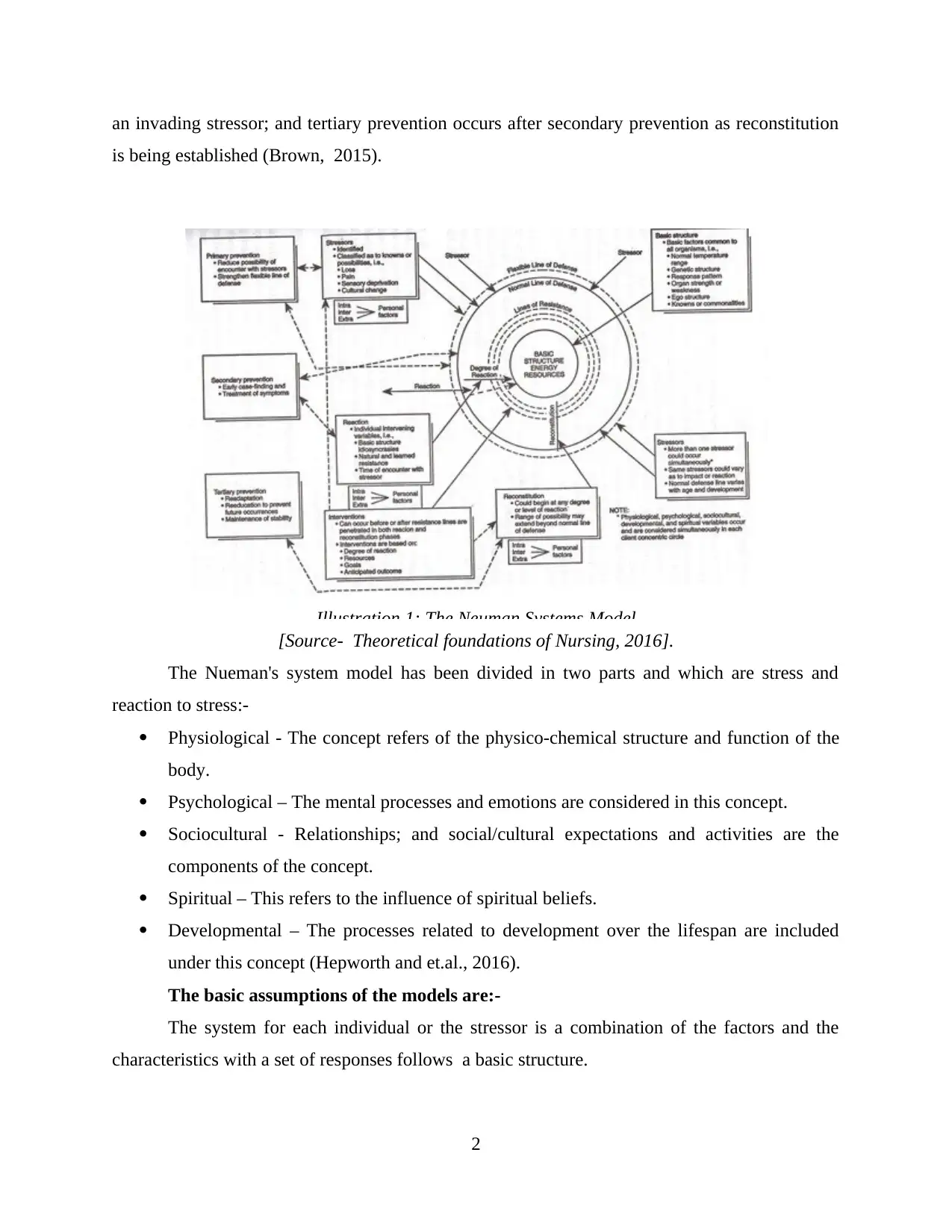
an invading stressor; and tertiary prevention occurs after secondary prevention as reconstitution
is being established (Brown, 2015).
[Source- Theoretical foundations of Nursing, 2016].
The Nueman's system model has been divided in two parts and which are stress and
reaction to stress:-
Physiological - The concept refers of the physico-chemical structure and function of the
body.
Psychological – The mental processes and emotions are considered in this concept.
Sociocultural - Relationships; and social/cultural expectations and activities are the
components of the concept.
Spiritual – This refers to the influence of spiritual beliefs.
Developmental – The processes related to development over the lifespan are included
under this concept (Hepworth and et.al., 2016).
The basic assumptions of the models are:-
The system for each individual or the stressor is a combination of the factors and the
characteristics with a set of responses follows a basic structure.
2
Illustration 1: The Neuman Systems Model
is being established (Brown, 2015).
[Source- Theoretical foundations of Nursing, 2016].
The Nueman's system model has been divided in two parts and which are stress and
reaction to stress:-
Physiological - The concept refers of the physico-chemical structure and function of the
body.
Psychological – The mental processes and emotions are considered in this concept.
Sociocultural - Relationships; and social/cultural expectations and activities are the
components of the concept.
Spiritual – This refers to the influence of spiritual beliefs.
Developmental – The processes related to development over the lifespan are included
under this concept (Hepworth and et.al., 2016).
The basic assumptions of the models are:-
The system for each individual or the stressor is a combination of the factors and the
characteristics with a set of responses follows a basic structure.
2
Illustration 1: The Neuman Systems Model
Paraphrase This Document
Need a fresh take? Get an instant paraphrase of this document with our AI Paraphraser
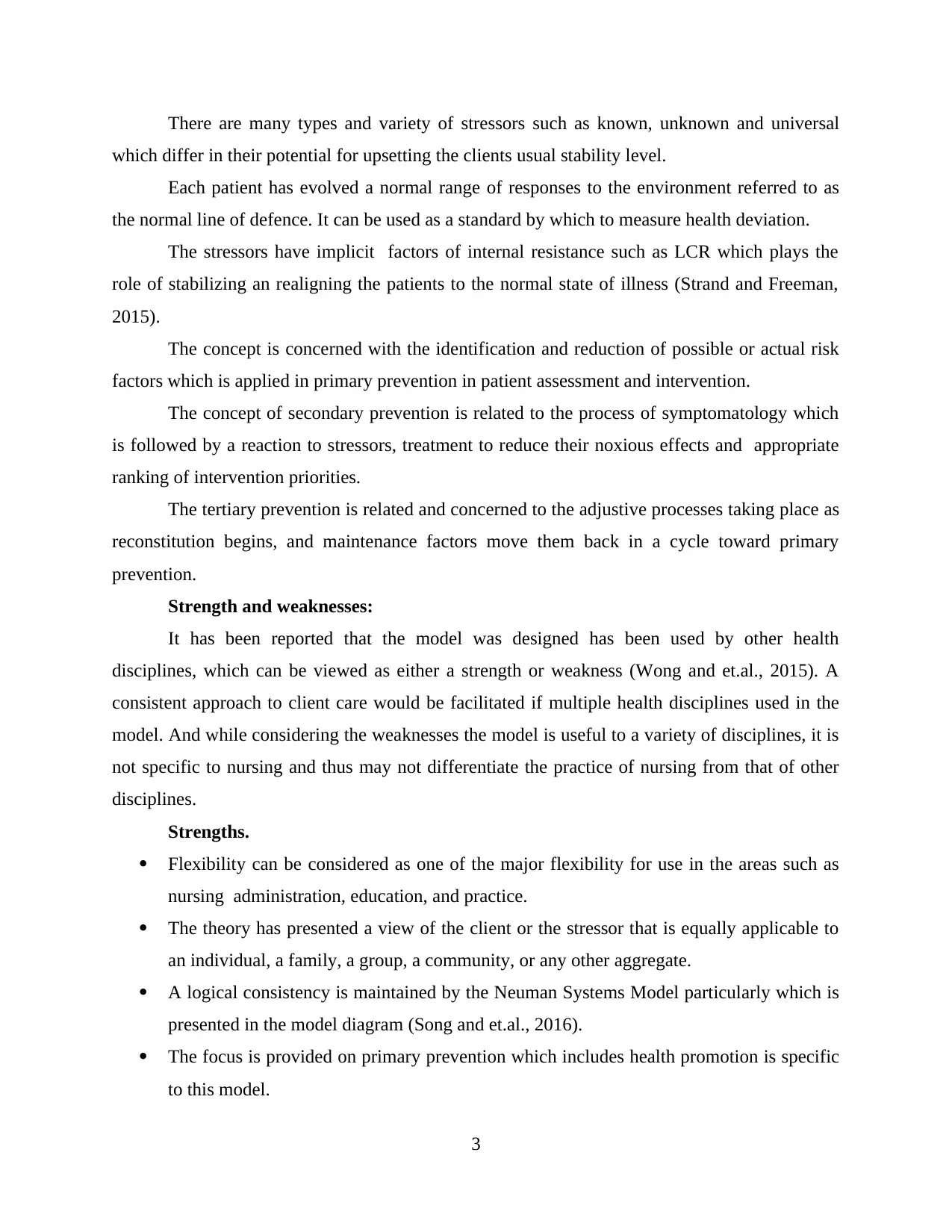
There are many types and variety of stressors such as known, unknown and universal
which differ in their potential for upsetting the clients usual stability level.
Each patient has evolved a normal range of responses to the environment referred to as
the normal line of defence. It can be used as a standard by which to measure health deviation.
The stressors have implicit factors of internal resistance such as LCR which plays the
role of stabilizing an realigning the patients to the normal state of illness (Strand and Freeman,
2015).
The concept is concerned with the identification and reduction of possible or actual risk
factors which is applied in primary prevention in patient assessment and intervention.
The concept of secondary prevention is related to the process of symptomatology which
is followed by a reaction to stressors, treatment to reduce their noxious effects and appropriate
ranking of intervention priorities.
The tertiary prevention is related and concerned to the adjustive processes taking place as
reconstitution begins, and maintenance factors move them back in a cycle toward primary
prevention.
Strength and weaknesses:
It has been reported that the model was designed has been used by other health
disciplines, which can be viewed as either a strength or weakness (Wong and et.al., 2015). A
consistent approach to client care would be facilitated if multiple health disciplines used in the
model. And while considering the weaknesses the model is useful to a variety of disciplines, it is
not specific to nursing and thus may not differentiate the practice of nursing from that of other
disciplines.
Strengths.
Flexibility can be considered as one of the major flexibility for use in the areas such as
nursing administration, education, and practice.
The theory has presented a view of the client or the stressor that is equally applicable to
an individual, a family, a group, a community, or any other aggregate.
A logical consistency is maintained by the Neuman Systems Model particularly which is
presented in the model diagram (Song and et.al., 2016).
The focus is provided on primary prevention which includes health promotion is specific
to this model.
3
which differ in their potential for upsetting the clients usual stability level.
Each patient has evolved a normal range of responses to the environment referred to as
the normal line of defence. It can be used as a standard by which to measure health deviation.
The stressors have implicit factors of internal resistance such as LCR which plays the
role of stabilizing an realigning the patients to the normal state of illness (Strand and Freeman,
2015).
The concept is concerned with the identification and reduction of possible or actual risk
factors which is applied in primary prevention in patient assessment and intervention.
The concept of secondary prevention is related to the process of symptomatology which
is followed by a reaction to stressors, treatment to reduce their noxious effects and appropriate
ranking of intervention priorities.
The tertiary prevention is related and concerned to the adjustive processes taking place as
reconstitution begins, and maintenance factors move them back in a cycle toward primary
prevention.
Strength and weaknesses:
It has been reported that the model was designed has been used by other health
disciplines, which can be viewed as either a strength or weakness (Wong and et.al., 2015). A
consistent approach to client care would be facilitated if multiple health disciplines used in the
model. And while considering the weaknesses the model is useful to a variety of disciplines, it is
not specific to nursing and thus may not differentiate the practice of nursing from that of other
disciplines.
Strengths.
Flexibility can be considered as one of the major flexibility for use in the areas such as
nursing administration, education, and practice.
The theory has presented a view of the client or the stressor that is equally applicable to
an individual, a family, a group, a community, or any other aggregate.
A logical consistency is maintained by the Neuman Systems Model particularly which is
presented in the model diagram (Song and et.al., 2016).
The focus is provided on primary prevention which includes health promotion is specific
to this model.
3

Once understood, the Neuman Systems Model is relatively simple, and has readily
acceptable definitions of its components.
Weaknesses.
The major weakness of the model is the need for further clarification of terms used.
Interpersonal and extra-personal stressors need to be more clearly differentiated.
The Self-Care Nursing Deficit Theory
The theory was developed by the Dorothea Orem. It secondary name is orem theory
model (Xing and et.al., 2015). This nursing study to helps make independent to the patients. This
model of nursing based on view point of that patient care themselves better. It is stimulate to
sufferer to quickly recovery from sickness with self dependency. It is consist 3 integral theories:
Self care theory.
Deficit self care theory. Nursing care system (Kurtessis and et.al., 2015).
Concept of Orem: there are few major concepts described as under:
Human: it can be defines as the women, men and children provide care by single or by
group of people and are objects of substantial of caring by the nurse or other person who give the
care to sick.
Environment: it involves the external factor such chemical, organic and physical, family
and society are the part of the environment.
Health: it is refer as the well being of the human by physically and mentally. Its also
cover the individual and team of people health. It is capability to interact with others through
communicate others (Cattaneo and Goodman, 2015).
Self-care: it is refer as the practices that opt by an individual to care themselves to get
recover from the sickness. Self care assist to enhance motivation of them.
Self-care agency: it defines as the capability of human being that engagement of them
with those efforts of the care and is affected by basic situational aspects.
Basic conditioning factor: it is involve basic factors such as the gender, developmental
and health state, age of the needed person, family and health care method, climate and way of
living, availability of the require resources (Webster-Stratton, 2015).
4
acceptable definitions of its components.
Weaknesses.
The major weakness of the model is the need for further clarification of terms used.
Interpersonal and extra-personal stressors need to be more clearly differentiated.
The Self-Care Nursing Deficit Theory
The theory was developed by the Dorothea Orem. It secondary name is orem theory
model (Xing and et.al., 2015). This nursing study to helps make independent to the patients. This
model of nursing based on view point of that patient care themselves better. It is stimulate to
sufferer to quickly recovery from sickness with self dependency. It is consist 3 integral theories:
Self care theory.
Deficit self care theory. Nursing care system (Kurtessis and et.al., 2015).
Concept of Orem: there are few major concepts described as under:
Human: it can be defines as the women, men and children provide care by single or by
group of people and are objects of substantial of caring by the nurse or other person who give the
care to sick.
Environment: it involves the external factor such chemical, organic and physical, family
and society are the part of the environment.
Health: it is refer as the well being of the human by physically and mentally. Its also
cover the individual and team of people health. It is capability to interact with others through
communicate others (Cattaneo and Goodman, 2015).
Self-care: it is refer as the practices that opt by an individual to care themselves to get
recover from the sickness. Self care assist to enhance motivation of them.
Self-care agency: it defines as the capability of human being that engagement of them
with those efforts of the care and is affected by basic situational aspects.
Basic conditioning factor: it is involve basic factors such as the gender, developmental
and health state, age of the needed person, family and health care method, climate and way of
living, availability of the require resources (Webster-Stratton, 2015).
4
⊘ This is a preview!⊘
Do you want full access?
Subscribe today to unlock all pages.

Trusted by 1+ million students worldwide
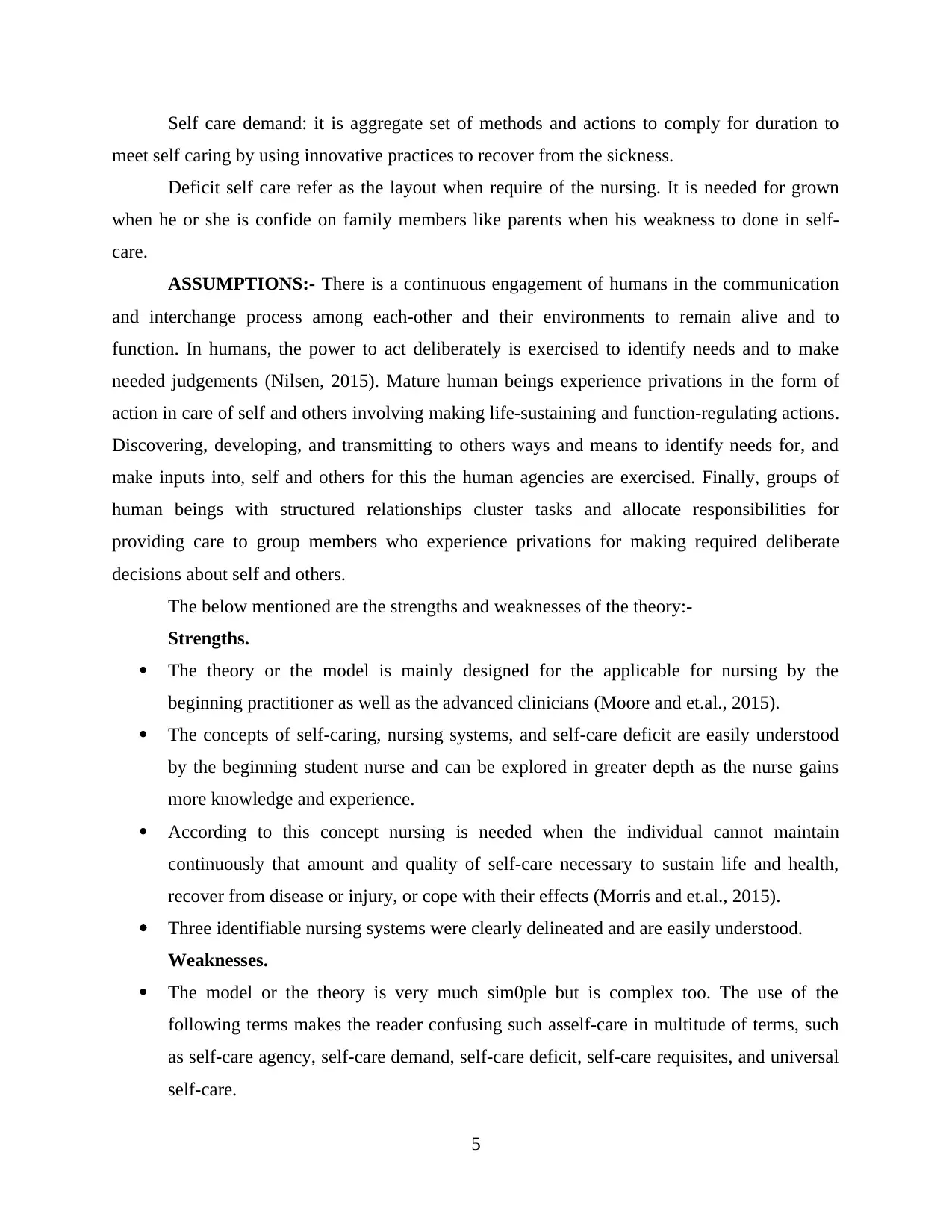
Self care demand: it is aggregate set of methods and actions to comply for duration to
meet self caring by using innovative practices to recover from the sickness.
Deficit self care refer as the layout when require of the nursing. It is needed for grown
when he or she is confide on family members like parents when his weakness to done in self-
care.
ASSUMPTIONS:- There is a continuous engagement of humans in the communication
and interchange process among each-other and their environments to remain alive and to
function. In humans, the power to act deliberately is exercised to identify needs and to make
needed judgements (Nilsen, 2015). Mature human beings experience privations in the form of
action in care of self and others involving making life-sustaining and function-regulating actions.
Discovering, developing, and transmitting to others ways and means to identify needs for, and
make inputs into, self and others for this the human agencies are exercised. Finally, groups of
human beings with structured relationships cluster tasks and allocate responsibilities for
providing care to group members who experience privations for making required deliberate
decisions about self and others.
The below mentioned are the strengths and weaknesses of the theory:-
Strengths.
The theory or the model is mainly designed for the applicable for nursing by the
beginning practitioner as well as the advanced clinicians (Moore and et.al., 2015).
The concepts of self-caring, nursing systems, and self-care deficit are easily understood
by the beginning student nurse and can be explored in greater depth as the nurse gains
more knowledge and experience.
According to this concept nursing is needed when the individual cannot maintain
continuously that amount and quality of self-care necessary to sustain life and health,
recover from disease or injury, or cope with their effects (Morris and et.al., 2015).
Three identifiable nursing systems were clearly delineated and are easily understood.
Weaknesses.
The model or the theory is very much sim0ple but is complex too. The use of the
following terms makes the reader confusing such asself-care in multitude of terms, such
as self-care agency, self-care demand, self-care deficit, self-care requisites, and universal
self-care.
5
meet self caring by using innovative practices to recover from the sickness.
Deficit self care refer as the layout when require of the nursing. It is needed for grown
when he or she is confide on family members like parents when his weakness to done in self-
care.
ASSUMPTIONS:- There is a continuous engagement of humans in the communication
and interchange process among each-other and their environments to remain alive and to
function. In humans, the power to act deliberately is exercised to identify needs and to make
needed judgements (Nilsen, 2015). Mature human beings experience privations in the form of
action in care of self and others involving making life-sustaining and function-regulating actions.
Discovering, developing, and transmitting to others ways and means to identify needs for, and
make inputs into, self and others for this the human agencies are exercised. Finally, groups of
human beings with structured relationships cluster tasks and allocate responsibilities for
providing care to group members who experience privations for making required deliberate
decisions about self and others.
The below mentioned are the strengths and weaknesses of the theory:-
Strengths.
The theory or the model is mainly designed for the applicable for nursing by the
beginning practitioner as well as the advanced clinicians (Moore and et.al., 2015).
The concepts of self-caring, nursing systems, and self-care deficit are easily understood
by the beginning student nurse and can be explored in greater depth as the nurse gains
more knowledge and experience.
According to this concept nursing is needed when the individual cannot maintain
continuously that amount and quality of self-care necessary to sustain life and health,
recover from disease or injury, or cope with their effects (Morris and et.al., 2015).
Three identifiable nursing systems were clearly delineated and are easily understood.
Weaknesses.
The model or the theory is very much sim0ple but is complex too. The use of the
following terms makes the reader confusing such asself-care in multitude of terms, such
as self-care agency, self-care demand, self-care deficit, self-care requisites, and universal
self-care.
5
Paraphrase This Document
Need a fresh take? Get an instant paraphrase of this document with our AI Paraphraser
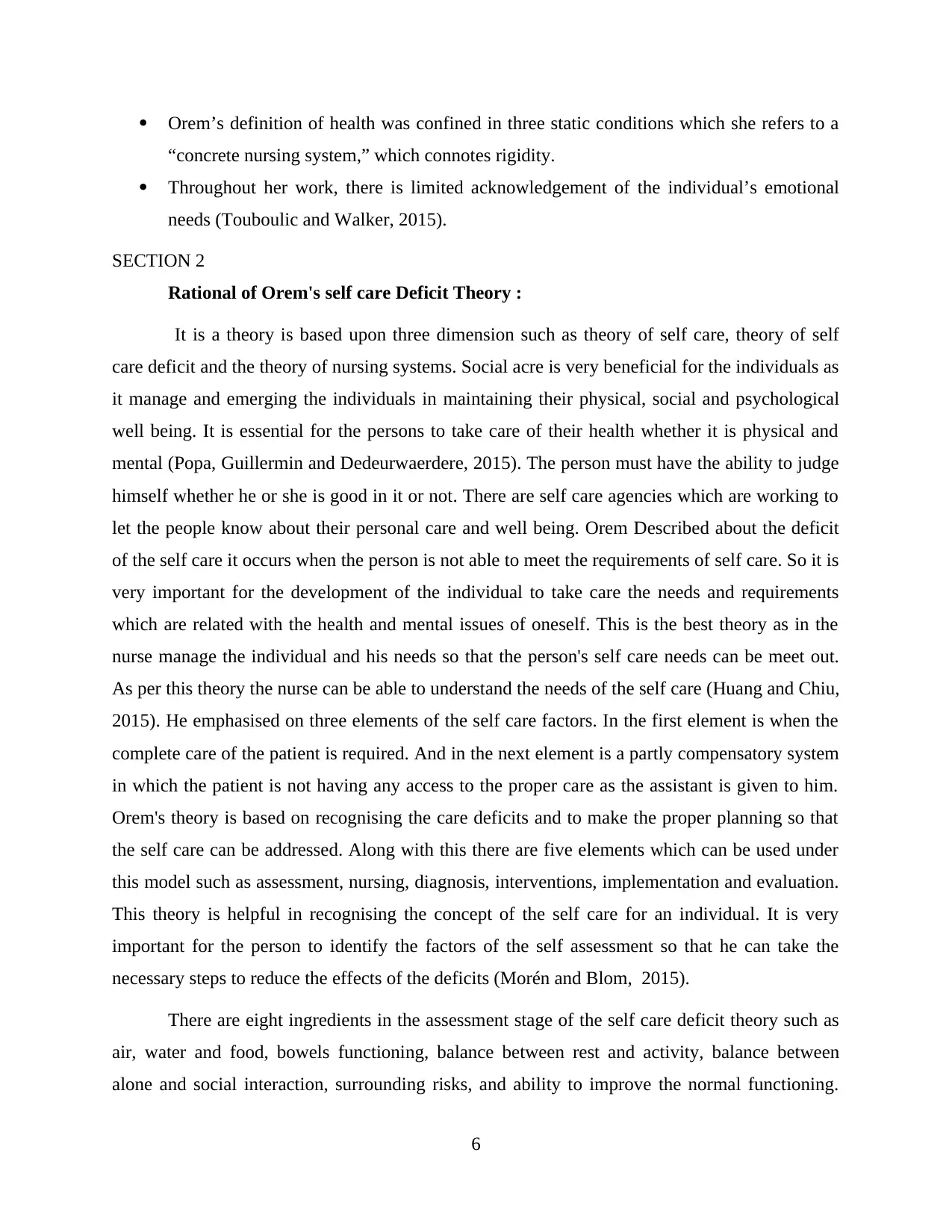
Orem’s definition of health was confined in three static conditions which she refers to a
“concrete nursing system,” which connotes rigidity.
Throughout her work, there is limited acknowledgement of the individual’s emotional
needs (Touboulic and Walker, 2015).
SECTION 2
Rational of Orem's self care Deficit Theory :
It is a theory is based upon three dimension such as theory of self care, theory of self
care deficit and the theory of nursing systems. Social acre is very beneficial for the individuals as
it manage and emerging the individuals in maintaining their physical, social and psychological
well being. It is essential for the persons to take care of their health whether it is physical and
mental (Popa, Guillermin and Dedeurwaerdere, 2015). The person must have the ability to judge
himself whether he or she is good in it or not. There are self care agencies which are working to
let the people know about their personal care and well being. Orem Described about the deficit
of the self care it occurs when the person is not able to meet the requirements of self care. So it is
very important for the development of the individual to take care the needs and requirements
which are related with the health and mental issues of oneself. This is the best theory as in the
nurse manage the individual and his needs so that the person's self care needs can be meet out.
As per this theory the nurse can be able to understand the needs of the self care (Huang and Chiu,
2015). He emphasised on three elements of the self care factors. In the first element is when the
complete care of the patient is required. And in the next element is a partly compensatory system
in which the patient is not having any access to the proper care as the assistant is given to him.
Orem's theory is based on recognising the care deficits and to make the proper planning so that
the self care can be addressed. Along with this there are five elements which can be used under
this model such as assessment, nursing, diagnosis, interventions, implementation and evaluation.
This theory is helpful in recognising the concept of the self care for an individual. It is very
important for the person to identify the factors of the self assessment so that he can take the
necessary steps to reduce the effects of the deficits (Morén and Blom, 2015).
There are eight ingredients in the assessment stage of the self care deficit theory such as
air, water and food, bowels functioning, balance between rest and activity, balance between
alone and social interaction, surrounding risks, and ability to improve the normal functioning.
6
“concrete nursing system,” which connotes rigidity.
Throughout her work, there is limited acknowledgement of the individual’s emotional
needs (Touboulic and Walker, 2015).
SECTION 2
Rational of Orem's self care Deficit Theory :
It is a theory is based upon three dimension such as theory of self care, theory of self
care deficit and the theory of nursing systems. Social acre is very beneficial for the individuals as
it manage and emerging the individuals in maintaining their physical, social and psychological
well being. It is essential for the persons to take care of their health whether it is physical and
mental (Popa, Guillermin and Dedeurwaerdere, 2015). The person must have the ability to judge
himself whether he or she is good in it or not. There are self care agencies which are working to
let the people know about their personal care and well being. Orem Described about the deficit
of the self care it occurs when the person is not able to meet the requirements of self care. So it is
very important for the development of the individual to take care the needs and requirements
which are related with the health and mental issues of oneself. This is the best theory as in the
nurse manage the individual and his needs so that the person's self care needs can be meet out.
As per this theory the nurse can be able to understand the needs of the self care (Huang and Chiu,
2015). He emphasised on three elements of the self care factors. In the first element is when the
complete care of the patient is required. And in the next element is a partly compensatory system
in which the patient is not having any access to the proper care as the assistant is given to him.
Orem's theory is based on recognising the care deficits and to make the proper planning so that
the self care can be addressed. Along with this there are five elements which can be used under
this model such as assessment, nursing, diagnosis, interventions, implementation and evaluation.
This theory is helpful in recognising the concept of the self care for an individual. It is very
important for the person to identify the factors of the self assessment so that he can take the
necessary steps to reduce the effects of the deficits (Morén and Blom, 2015).
There are eight ingredients in the assessment stage of the self care deficit theory such as
air, water and food, bowels functioning, balance between rest and activity, balance between
alone and social interaction, surrounding risks, and ability to improve the normal functioning.
6
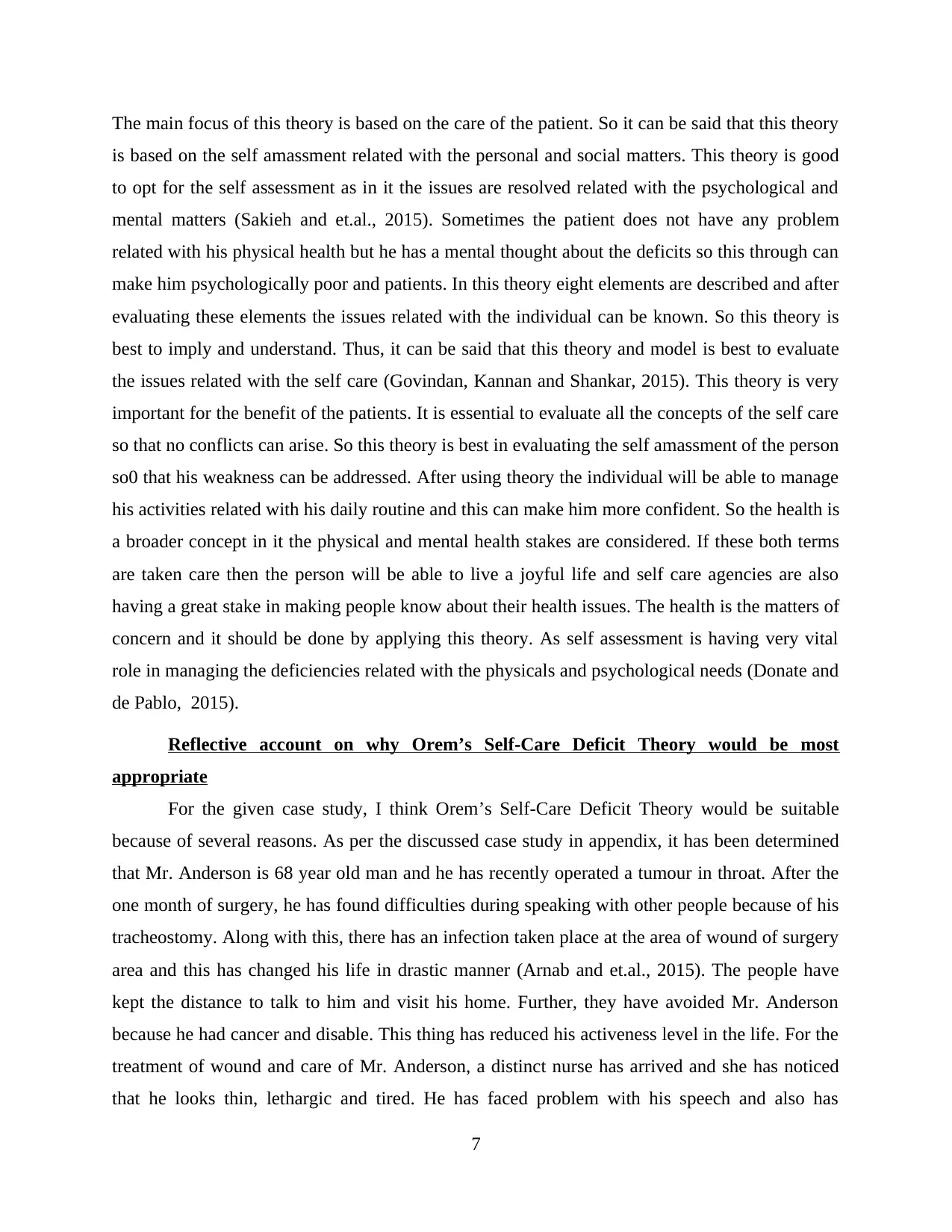
The main focus of this theory is based on the care of the patient. So it can be said that this theory
is based on the self amassment related with the personal and social matters. This theory is good
to opt for the self assessment as in it the issues are resolved related with the psychological and
mental matters (Sakieh and et.al., 2015). Sometimes the patient does not have any problem
related with his physical health but he has a mental thought about the deficits so this through can
make him psychologically poor and patients. In this theory eight elements are described and after
evaluating these elements the issues related with the individual can be known. So this theory is
best to imply and understand. Thus, it can be said that this theory and model is best to evaluate
the issues related with the self care (Govindan, Kannan and Shankar, 2015). This theory is very
important for the benefit of the patients. It is essential to evaluate all the concepts of the self care
so that no conflicts can arise. So this theory is best in evaluating the self amassment of the person
so0 that his weakness can be addressed. After using theory the individual will be able to manage
his activities related with his daily routine and this can make him more confident. So the health is
a broader concept in it the physical and mental health stakes are considered. If these both terms
are taken care then the person will be able to live a joyful life and self care agencies are also
having a great stake in making people know about their health issues. The health is the matters of
concern and it should be done by applying this theory. As self assessment is having very vital
role in managing the deficiencies related with the physicals and psychological needs (Donate and
de Pablo, 2015).
Reflective account on why Orem’s Self-Care Deficit Theory would be most
appropriate
For the given case study, I think Orem’s Self-Care Deficit Theory would be suitable
because of several reasons. As per the discussed case study in appendix, it has been determined
that Mr. Anderson is 68 year old man and he has recently operated a tumour in throat. After the
one month of surgery, he has found difficulties during speaking with other people because of his
tracheostomy. Along with this, there has an infection taken place at the area of wound of surgery
area and this has changed his life in drastic manner (Arnab and et.al., 2015). The people have
kept the distance to talk to him and visit his home. Further, they have avoided Mr. Anderson
because he had cancer and disable. This thing has reduced his activeness level in the life. For the
treatment of wound and care of Mr. Anderson, a distinct nurse has arrived and she has noticed
that he looks thin, lethargic and tired. He has faced problem with his speech and also has
7
is based on the self amassment related with the personal and social matters. This theory is good
to opt for the self assessment as in it the issues are resolved related with the psychological and
mental matters (Sakieh and et.al., 2015). Sometimes the patient does not have any problem
related with his physical health but he has a mental thought about the deficits so this through can
make him psychologically poor and patients. In this theory eight elements are described and after
evaluating these elements the issues related with the individual can be known. So this theory is
best to imply and understand. Thus, it can be said that this theory and model is best to evaluate
the issues related with the self care (Govindan, Kannan and Shankar, 2015). This theory is very
important for the benefit of the patients. It is essential to evaluate all the concepts of the self care
so that no conflicts can arise. So this theory is best in evaluating the self amassment of the person
so0 that his weakness can be addressed. After using theory the individual will be able to manage
his activities related with his daily routine and this can make him more confident. So the health is
a broader concept in it the physical and mental health stakes are considered. If these both terms
are taken care then the person will be able to live a joyful life and self care agencies are also
having a great stake in making people know about their health issues. The health is the matters of
concern and it should be done by applying this theory. As self assessment is having very vital
role in managing the deficiencies related with the physicals and psychological needs (Donate and
de Pablo, 2015).
Reflective account on why Orem’s Self-Care Deficit Theory would be most
appropriate
For the given case study, I think Orem’s Self-Care Deficit Theory would be suitable
because of several reasons. As per the discussed case study in appendix, it has been determined
that Mr. Anderson is 68 year old man and he has recently operated a tumour in throat. After the
one month of surgery, he has found difficulties during speaking with other people because of his
tracheostomy. Along with this, there has an infection taken place at the area of wound of surgery
area and this has changed his life in drastic manner (Arnab and et.al., 2015). The people have
kept the distance to talk to him and visit his home. Further, they have avoided Mr. Anderson
because he had cancer and disable. This thing has reduced his activeness level in the life. For the
treatment of wound and care of Mr. Anderson, a distinct nurse has arrived and she has noticed
that he looks thin, lethargic and tired. He has faced problem with his speech and also has
7
⊘ This is a preview!⊘
Do you want full access?
Subscribe today to unlock all pages.

Trusted by 1+ million students worldwide
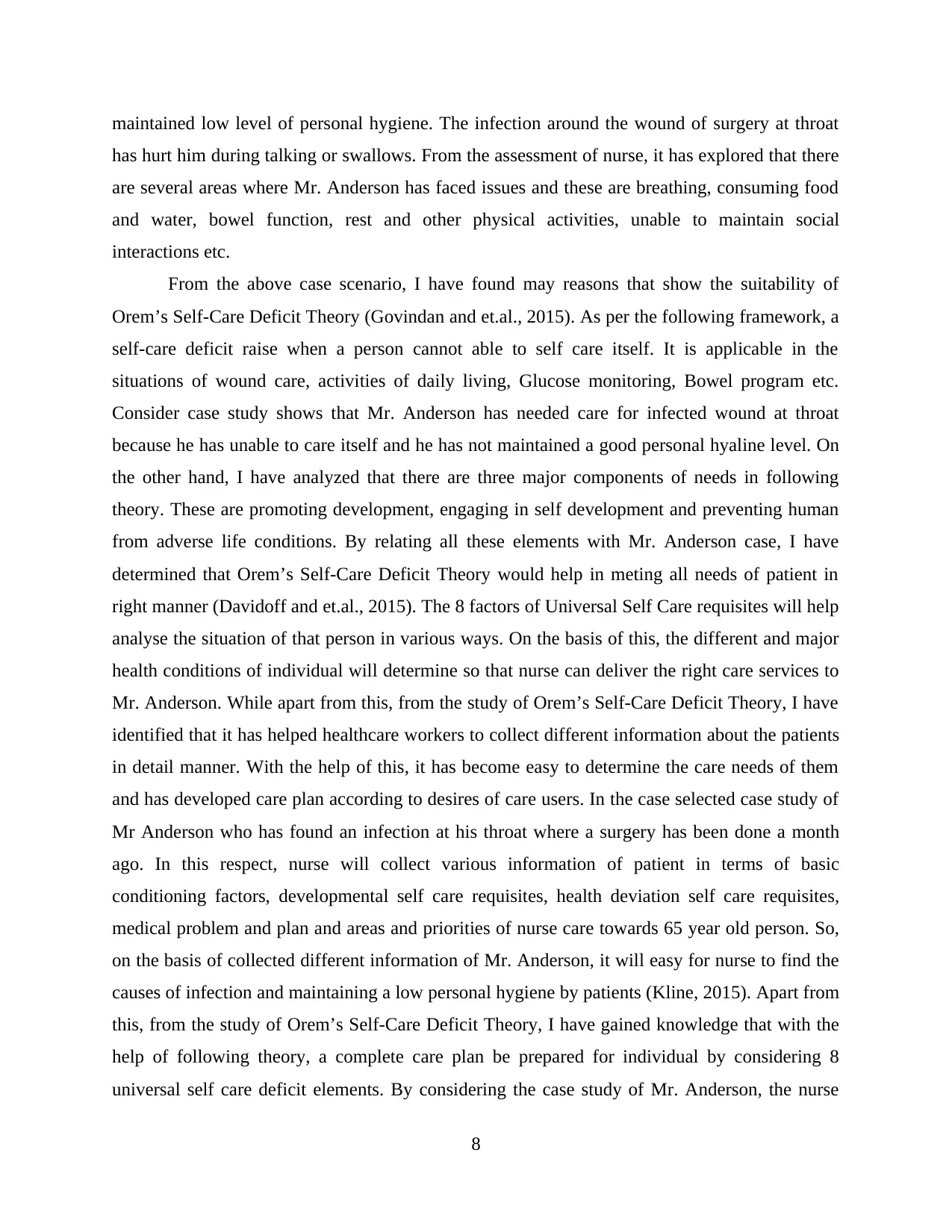
maintained low level of personal hygiene. The infection around the wound of surgery at throat
has hurt him during talking or swallows. From the assessment of nurse, it has explored that there
are several areas where Mr. Anderson has faced issues and these are breathing, consuming food
and water, bowel function, rest and other physical activities, unable to maintain social
interactions etc.
From the above case scenario, I have found may reasons that show the suitability of
Orem’s Self-Care Deficit Theory (Govindan and et.al., 2015). As per the following framework, a
self-care deficit raise when a person cannot able to self care itself. It is applicable in the
situations of wound care, activities of daily living, Glucose monitoring, Bowel program etc.
Consider case study shows that Mr. Anderson has needed care for infected wound at throat
because he has unable to care itself and he has not maintained a good personal hyaline level. On
the other hand, I have analyzed that there are three major components of needs in following
theory. These are promoting development, engaging in self development and preventing human
from adverse life conditions. By relating all these elements with Mr. Anderson case, I have
determined that Orem’s Self-Care Deficit Theory would help in meting all needs of patient in
right manner (Davidoff and et.al., 2015). The 8 factors of Universal Self Care requisites will help
analyse the situation of that person in various ways. On the basis of this, the different and major
health conditions of individual will determine so that nurse can deliver the right care services to
Mr. Anderson. While apart from this, from the study of Orem’s Self-Care Deficit Theory, I have
identified that it has helped healthcare workers to collect different information about the patients
in detail manner. With the help of this, it has become easy to determine the care needs of them
and has developed care plan according to desires of care users. In the case selected case study of
Mr Anderson who has found an infection at his throat where a surgery has been done a month
ago. In this respect, nurse will collect various information of patient in terms of basic
conditioning factors, developmental self care requisites, health deviation self care requisites,
medical problem and plan and areas and priorities of nurse care towards 65 year old person. So,
on the basis of collected different information of Mr. Anderson, it will easy for nurse to find the
causes of infection and maintaining a low personal hygiene by patients (Kline, 2015). Apart from
this, from the study of Orem’s Self-Care Deficit Theory, I have gained knowledge that with the
help of following theory, a complete care plan be prepared for individual by considering 8
universal self care deficit elements. By considering the case study of Mr. Anderson, the nurse
8
has hurt him during talking or swallows. From the assessment of nurse, it has explored that there
are several areas where Mr. Anderson has faced issues and these are breathing, consuming food
and water, bowel function, rest and other physical activities, unable to maintain social
interactions etc.
From the above case scenario, I have found may reasons that show the suitability of
Orem’s Self-Care Deficit Theory (Govindan and et.al., 2015). As per the following framework, a
self-care deficit raise when a person cannot able to self care itself. It is applicable in the
situations of wound care, activities of daily living, Glucose monitoring, Bowel program etc.
Consider case study shows that Mr. Anderson has needed care for infected wound at throat
because he has unable to care itself and he has not maintained a good personal hyaline level. On
the other hand, I have analyzed that there are three major components of needs in following
theory. These are promoting development, engaging in self development and preventing human
from adverse life conditions. By relating all these elements with Mr. Anderson case, I have
determined that Orem’s Self-Care Deficit Theory would help in meting all needs of patient in
right manner (Davidoff and et.al., 2015). The 8 factors of Universal Self Care requisites will help
analyse the situation of that person in various ways. On the basis of this, the different and major
health conditions of individual will determine so that nurse can deliver the right care services to
Mr. Anderson. While apart from this, from the study of Orem’s Self-Care Deficit Theory, I have
identified that it has helped healthcare workers to collect different information about the patients
in detail manner. With the help of this, it has become easy to determine the care needs of them
and has developed care plan according to desires of care users. In the case selected case study of
Mr Anderson who has found an infection at his throat where a surgery has been done a month
ago. In this respect, nurse will collect various information of patient in terms of basic
conditioning factors, developmental self care requisites, health deviation self care requisites,
medical problem and plan and areas and priorities of nurse care towards 65 year old person. So,
on the basis of collected different information of Mr. Anderson, it will easy for nurse to find the
causes of infection and maintaining a low personal hygiene by patients (Kline, 2015). Apart from
this, from the study of Orem’s Self-Care Deficit Theory, I have gained knowledge that with the
help of following theory, a complete care plan be prepared for individual by considering 8
universal self care deficit elements. By considering the case study of Mr. Anderson, the nurse
8
Paraphrase This Document
Need a fresh take? Get an instant paraphrase of this document with our AI Paraphraser
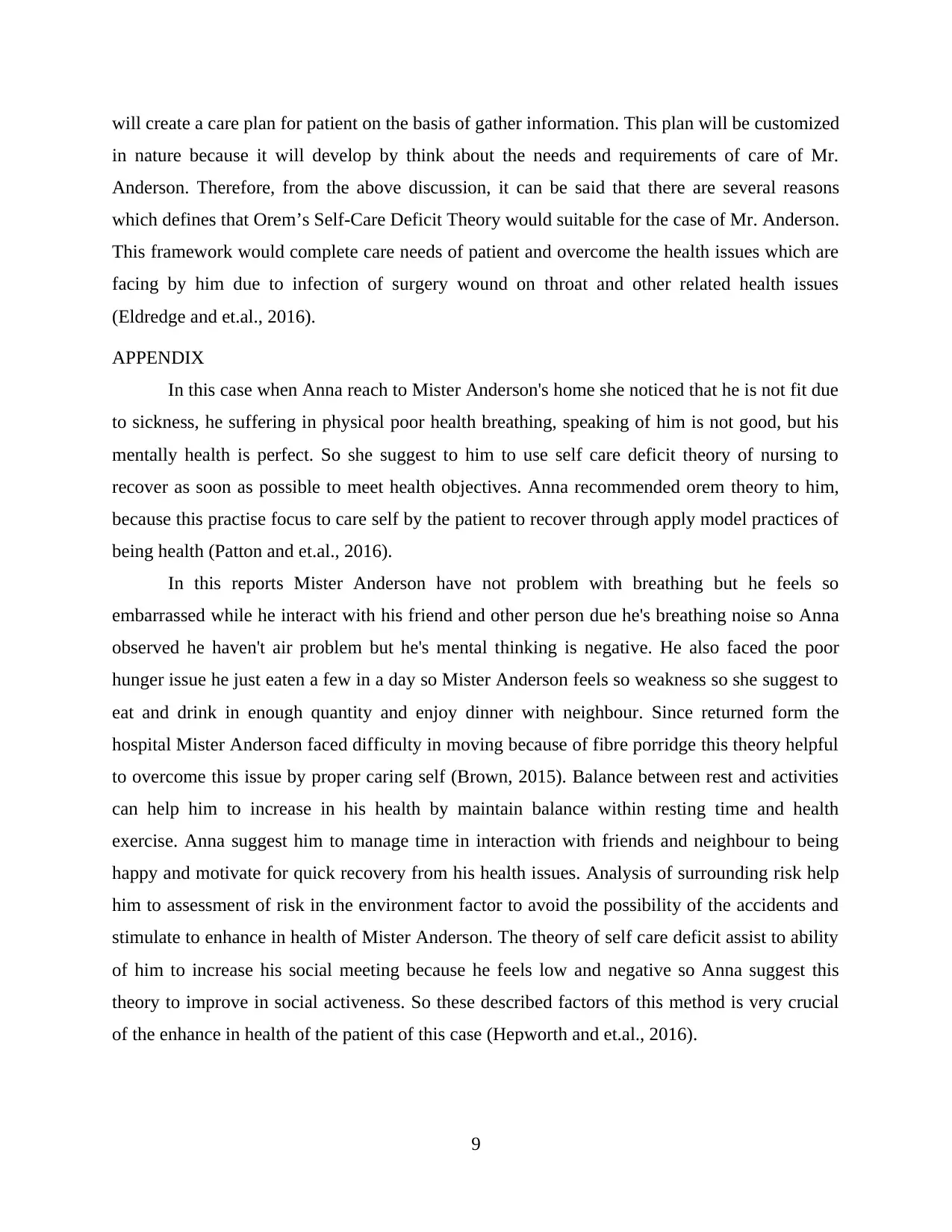
will create a care plan for patient on the basis of gather information. This plan will be customized
in nature because it will develop by think about the needs and requirements of care of Mr.
Anderson. Therefore, from the above discussion, it can be said that there are several reasons
which defines that Orem’s Self-Care Deficit Theory would suitable for the case of Mr. Anderson.
This framework would complete care needs of patient and overcome the health issues which are
facing by him due to infection of surgery wound on throat and other related health issues
(Eldredge and et.al., 2016).
APPENDIX
In this case when Anna reach to Mister Anderson's home she noticed that he is not fit due
to sickness, he suffering in physical poor health breathing, speaking of him is not good, but his
mentally health is perfect. So she suggest to him to use self care deficit theory of nursing to
recover as soon as possible to meet health objectives. Anna recommended orem theory to him,
because this practise focus to care self by the patient to recover through apply model practices of
being health (Patton and et.al., 2016).
In this reports Mister Anderson have not problem with breathing but he feels so
embarrassed while he interact with his friend and other person due he's breathing noise so Anna
observed he haven't air problem but he's mental thinking is negative. He also faced the poor
hunger issue he just eaten a few in a day so Mister Anderson feels so weakness so she suggest to
eat and drink in enough quantity and enjoy dinner with neighbour. Since returned form the
hospital Mister Anderson faced difficulty in moving because of fibre porridge this theory helpful
to overcome this issue by proper caring self (Brown, 2015). Balance between rest and activities
can help him to increase in his health by maintain balance within resting time and health
exercise. Anna suggest him to manage time in interaction with friends and neighbour to being
happy and motivate for quick recovery from his health issues. Analysis of surrounding risk help
him to assessment of risk in the environment factor to avoid the possibility of the accidents and
stimulate to enhance in health of Mister Anderson. The theory of self care deficit assist to ability
of him to increase his social meeting because he feels low and negative so Anna suggest this
theory to improve in social activeness. So these described factors of this method is very crucial
of the enhance in health of the patient of this case (Hepworth and et.al., 2016).
9
in nature because it will develop by think about the needs and requirements of care of Mr.
Anderson. Therefore, from the above discussion, it can be said that there are several reasons
which defines that Orem’s Self-Care Deficit Theory would suitable for the case of Mr. Anderson.
This framework would complete care needs of patient and overcome the health issues which are
facing by him due to infection of surgery wound on throat and other related health issues
(Eldredge and et.al., 2016).
APPENDIX
In this case when Anna reach to Mister Anderson's home she noticed that he is not fit due
to sickness, he suffering in physical poor health breathing, speaking of him is not good, but his
mentally health is perfect. So she suggest to him to use self care deficit theory of nursing to
recover as soon as possible to meet health objectives. Anna recommended orem theory to him,
because this practise focus to care self by the patient to recover through apply model practices of
being health (Patton and et.al., 2016).
In this reports Mister Anderson have not problem with breathing but he feels so
embarrassed while he interact with his friend and other person due he's breathing noise so Anna
observed he haven't air problem but he's mental thinking is negative. He also faced the poor
hunger issue he just eaten a few in a day so Mister Anderson feels so weakness so she suggest to
eat and drink in enough quantity and enjoy dinner with neighbour. Since returned form the
hospital Mister Anderson faced difficulty in moving because of fibre porridge this theory helpful
to overcome this issue by proper caring self (Brown, 2015). Balance between rest and activities
can help him to increase in his health by maintain balance within resting time and health
exercise. Anna suggest him to manage time in interaction with friends and neighbour to being
happy and motivate for quick recovery from his health issues. Analysis of surrounding risk help
him to assessment of risk in the environment factor to avoid the possibility of the accidents and
stimulate to enhance in health of Mister Anderson. The theory of self care deficit assist to ability
of him to increase his social meeting because he feels low and negative so Anna suggest this
theory to improve in social activeness. So these described factors of this method is very crucial
of the enhance in health of the patient of this case (Hepworth and et.al., 2016).
9
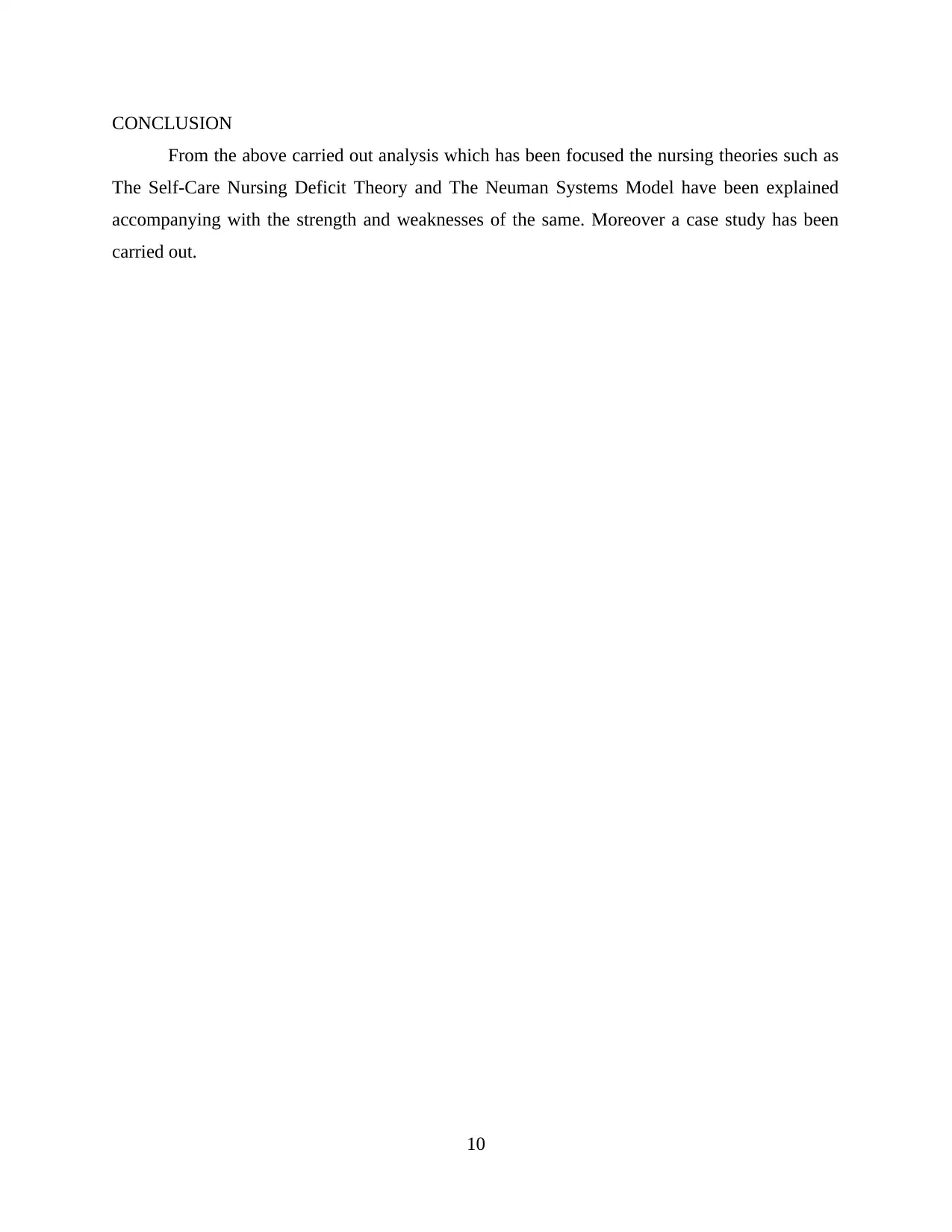
CONCLUSION
From the above carried out analysis which has been focused the nursing theories such as
The Self-Care Nursing Deficit Theory and The Neuman Systems Model have been explained
accompanying with the strength and weaknesses of the same. Moreover a case study has been
carried out.
10
From the above carried out analysis which has been focused the nursing theories such as
The Self-Care Nursing Deficit Theory and The Neuman Systems Model have been explained
accompanying with the strength and weaknesses of the same. Moreover a case study has been
carried out.
10
⊘ This is a preview!⊘
Do you want full access?
Subscribe today to unlock all pages.

Trusted by 1+ million students worldwide
1 out of 15
Related Documents
Your All-in-One AI-Powered Toolkit for Academic Success.
+13062052269
info@desklib.com
Available 24*7 on WhatsApp / Email
![[object Object]](/_next/static/media/star-bottom.7253800d.svg)
Unlock your academic potential
Copyright © 2020–2025 A2Z Services. All Rights Reserved. Developed and managed by ZUCOL.





